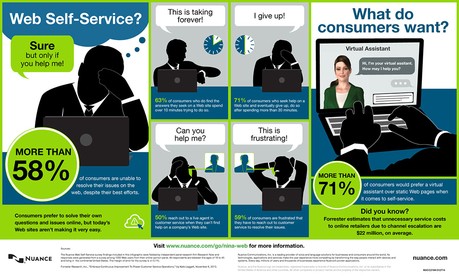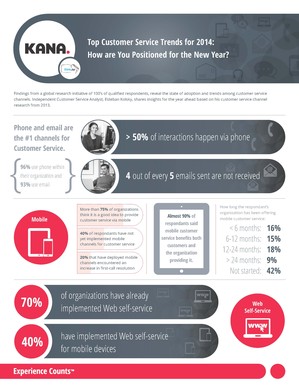Patterns from Customer Service Suppliers’ VOC
Survey Results from KANA and Nuance about Customers’ Service Experiences
How do customers attempt to answer questions and solve problems with products and companies? In 2013, the 63% of customers who successfully resolved their issues using customer self-service chan-nels spent over 10 minutes doing so. Of those who weren’t successful, 71% of them spent over 30 minutes trying to resolve their issues via self-service.
NETTING IT OUT
In late 2013, KANA and Nuance published the results of (multiple) surveys that each company had conducted or sponsored over the previous several months. All of the surveys were about customer service. The answers to survey questions demonstrated customers’ approach, behavior, preferences, and issues in their attempts to get service from the companies with which they’ve chosen to do business. The responses to these surveys are the Voices of the Customers for and about customer service. This is wonderful stuff!
Now, to be sure, suppliers conduct surveys for market research and marketing purposes. Suppliers’ objectives for surveys are often to use the Voice of the Customer (VOC) to prove/disprove, validate, demonstrate, or even promote their products, services, or programs. Certainly, both of the surveys our suppliers published achieved those objectives. For this article though, let’s focus on the broader value of the surveys, the Voice of the Customer for Customer Service.
The most surprising results of these surveys were how much time and effort customers are willing to spend to get answers, solutions, and to complain.
 SURVEYING THE VOICE OF THE CUSTOMER
SURVEYING THE VOICE OF THE CUSTOMER
Surveys about Customers’ Service Experiences across Companies
The objective in these surveys is to represent the activities that customers perform or the steps that customers follow to get customer service from the companies with which they choose to do business. In other words, getting answers to their questions and (re)solutions to their problems. If we order our survey examination and analyses of the typical sequence of steps that customers take, we can see that they represent a Customer Scenario. Remember that a Customer Scenario is the sequence of activities that customers want to follow in order to accomplish an objective they want to obtain. For a customer service scenario, customers typically:
- Access Customer Service. Login to their accounts or to the customer service section of their companies’ web sites or call their companies’ contact center and get authenticated to speak with customer service agents
- Find Answers and (Re)solutions. Use self-service, social-service, virtual assisted-service, and/or assisted-service facilities to try to help themselves, seek the help of their peers, or seek the help of customer service agent for answers and (re)solutions.
- Complain. If customers can’t get answers or (re)solutions using these facilities, they complain to their providers.
The table (shown in the PDF) below shows how the surveys conducted by Nuance1 and Kana2 in late 2013 examine how customers perform these activities and how companies support those activities. Note that our analyses of survey results are based on the content of the press releases of the surveys. This content is a bit removed from the actual survey data.
Let’s listen closely to the Voices of the Customers as they perform the activities of the customer service Customer Scenario. For each of the surveys in the Table, we’ll present the published survey results, analyze them, and suggest what businesses might do to help customers perform the activities faster, more effectively, and more efficiently.
ACCESS TO CUSTOMER SERVICE
Managing Authentication
Before customers can ask questions or present problems related to their accounts, they often have to be authenticated on the customer service system that handles and manages these issues. Authentication typically requires usernames and passwords, basically login credentials. In these times of rampant identity theft, security of credentials has become critically important.
Nuance’s surveys on privacy and security of telephone credentials and on telephone authentication shed some light on customers’ issues with authentication...(more)
(Download the PDF to read the entire article.)
***Footnotes***
1. Nuance customer surveys conducted in Q42013 are listed on the company’s press page—search for “surveys”
2. Kana’s customer surveys conducted in the Q4 2013 are listed on the company’s press page: http://www.kana.com/about-kana/press
Sign in to download the full article
0 comments
Be the first one to comment.




